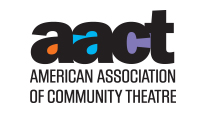Theatre Terms
 As a service to the theatre community, AACT provides over 1000 definitions of theatrical terms. Fully searchable, our glossary is helpful for technical staff, directors, actors, producers, or anyone wanting to better understand the inner workings of theatre.
As a service to the theatre community, AACT provides over 1000 definitions of theatrical terms. Fully searchable, our glossary is helpful for technical staff, directors, actors, producers, or anyone wanting to better understand the inner workings of theatre.
HOW TO SEARCH:
Click on a letter (A-Z) below to find terms beginning with the specified letter, OR enter a word in "Search for Term" OR search by entering a word in "Words in Definition." For example, entering the word "curtain" would display all words whose definition includes that word. (Note: If the A-Z or word search has been activated, it must be reset before using "Search for Term" or "Words in Definition." To reset the A-Z search: Click Here)
| Term | Definition | Link |
|---|---|---|
| LEKO | A commonly used term for an ellipsoidal spotlight, named after its inventors (Levy and Kook), the names Leko and Lekolite are trademarked by Strand Lighting Co. | |
| LENS | Optical glass with one or both sides curved, the purpose of which is to direct light by concentrating or dispersing light beams. | |
| LEVEL | 1) A platform or other area for acting, above the stage floor. 2) Generically, as in "levels," to indicate a director or choreographer's positioning of performers on platforms, steps, etc. in order to get a more interesting stage picture. | |
| LICENSE | On behalf of the author(s) the representative grants a license to produce the show and collects a fee, or "royalty," for this license. Built into each performance license is specific language which governs how the copyrighted work must be presented. The license is not valid until the representative has double-checked availability, sent you a confirmation of the terms, and your check has cleared. | |
| LIFT | The orchestra pit and/or sections of the stage may be mounted on lifts to make moving of heavy items (e.g. piano etc.) easier. Sometimes the forestage doubles as the orchestra pit by use of a lift. | |
| LIGHT CURTAIN | A lighting effect which, when an area is diffused with smoke, produces a wall of light. Produced (usually) by a batten of low voltage PAR lamps wired in series. Automated versions are available which have color changers built-in and are able to tilt up and down. | |
| LIGHT TREE | A vertical pole on which horizontal arms can be mounted, carrying instruments. Often used behind wings for side-lighting, etc. Trees (or booms) have a base plate or stand at the bottom and are tied off to the grid or fly floor at the top (not always necessary for short booms). Trees can also be fixed to the rear of the proscenium arch or hung from the ends of lighting bars. | |
| LIGHTING PLAN | Lighting Plot | |
| LIGHTING PLOT | A scale drawing detailing the exact location of each instrument used in a production and any other pertinent information (E.g. its dimmer number, focus position and color number). Often drawn from the theatres' groundplan. In U.K, this is called a Lighting Plan; the Lighting Plot there refers to the process of recording information about each lighting state either onto paper or into the memory of a computerized lighting board for subsequent playback. | |
| LIGHTING STATE | The format of lighting used at a particular point in the production; a lighting "picture." | |
| LIGHTING TEMPLATE | Plastic stencil containing a range of scale symbols for current lighting equipment. Greatly facilitates the drawing of lighting plans. The use of a template is now supplanted by computer aided design (CAD). | |
| LIMELIGHT | An obsolete source of intensely bright light, most recently used in followspots. See limes. Derived from a burning jet of oxygen and hydrogen impinging on a rotatable cylinder of lime. | |
| LINE | 1) A rope or wire used to hang scenery, etc. 2) A portion of dialogue, usually a sentence, but also a single row in the script (thus the origin of the word). Thus, to be up on one's lines, or to ask, "What's my next line?" or simply "Line?" | |
| LINE LEVEL SIGNAL | Standard level at which the inputs and outputs of domestic and professional sound equipment operate. Slight variations are that some equipment works at +4dB, some at -10dB. | |
| LINE REHEARSAL | A rehearsal for spoken lines rather than for body movements. | |
| LINK | ||
| LINNEBACH PROJECTOR | Lensless system for projecting a shape from a gel or glass slide etc. placed in front of a floodlight onto the set. Often used for shadow effects. | |
| LITTLE THEATRE | Any small theatre, but especially one for amateur productions, often with an interest in experimentation. | |
| LOAD | 1) The electrical power rating, in watts, of the equipment connected to a particular lighting dimmer. 2) The equipment connected to a dimmer. | |
| LOAD-IN | The process of, or time-period for, moving sets, props, etc, into a theatre before a production. |




